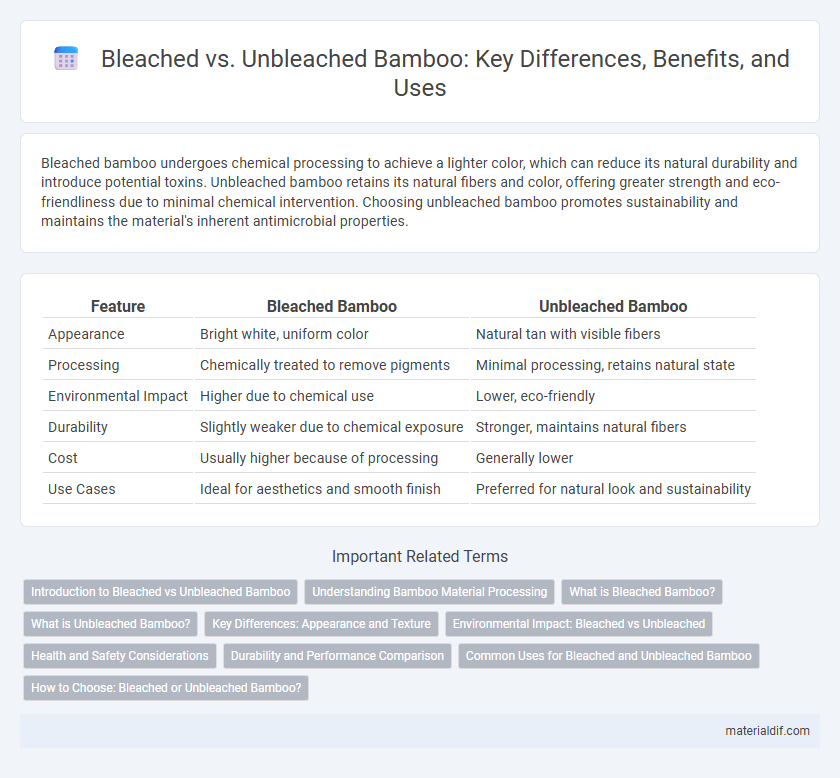Bleached bamboo undergoes chemical processing to achieve a lighter color, which can reduce its natural durability and introduce potential toxins. Unbleached bamboo retains its natural fibers and color, offering greater strength and eco-friendliness due to minimal chemical intervention. Choosing unbleached bamboo promotes sustainability and maintains the material's inherent antimicrobial properties.
Table of Comparison
| Feature | Bleached Bamboo | Unbleached Bamboo |
|---|---|---|
| Appearance | Bright white, uniform color | Natural tan with visible fibers |
| Processing | Chemically treated to remove pigments | Minimal processing, retains natural state |
| Environmental Impact | Higher due to chemical use | Lower, eco-friendly |
| Durability | Slightly weaker due to chemical exposure | Stronger, maintains natural fibers |
| Cost | Usually higher because of processing | Generally lower |
| Use Cases | Ideal for aesthetics and smooth finish | Preferred for natural look and sustainability |
Introduction to Bleached vs Unbleached Bamboo
Bleached bamboo undergoes a chemical process to achieve a lighter, more uniform appearance, enhancing its aesthetic appeal for textiles and flooring. Unbleached bamboo retains its natural color and organic properties, offering an eco-friendlier option with reduced exposure to chemicals. Choosing between bleached and unbleached bamboo depends on balancing environmental impact, desired appearance, and material performance.
Understanding Bamboo Material Processing
Bleached bamboo undergoes chemical treatments to remove natural pigments and achieve a lighter, uniform color, enhancing its aesthetic appeal but potentially reducing some natural antioxidants. Unbleached bamboo retains its natural color and fibers, preserving its inherent strength, durability, and eco-friendly qualities without exposure to harsh chemicals. Understanding these differences is crucial for selecting bamboo materials based on environmental impact, durability, and intended use.
What is Bleached Bamboo?
Bleached bamboo refers to bamboo fibers treated with chemical processes to remove their natural color, resulting in a lighter, more uniform appearance ideal for textiles and flooring. The bleaching process often uses hydrogen peroxide or other environmentally friendly agents to maintain the bamboo's softness while enhancing brightness. This contrasts with unbleached bamboo, which retains its natural golden hue and may contain more impurities or lignin, affecting texture and durability.
What is Unbleached Bamboo?
Unbleached bamboo refers to bamboo fibers that have not undergone chemical bleaching, preserving their natural color and strength. This type of bamboo is often favored for its eco-friendly qualities, as the absence of harsh bleaching agents reduces environmental impact. Unbleached bamboo products typically offer enhanced durability and maintain the plant's inherent antimicrobial properties.
Key Differences: Appearance and Texture
Bleached bamboo has a lighter, almost white appearance due to chemical treatments that remove its natural color, while unbleached bamboo retains its original golden-brown hue and visible grain patterns. The texture of bleached bamboo is smoother and more uniform, often treated to enhance softness, whereas unbleached bamboo has a slightly rougher, more natural feel with varied surface irregularities. These key differences affect their aesthetic appeal and application in products such as flooring, textiles, and furniture.
Environmental Impact: Bleached vs Unbleached
Bleached bamboo undergoes chemical treatments involving chlorine or oxygen-based agents that can release harmful pollutants and reduce biodegradability, increasing environmental impact. Unbleached bamboo avoids these chemicals, maintaining natural fibers and minimizing toxic waste, thus offering a more eco-friendly option. Choosing unbleached bamboo supports sustainable manufacturing practices and reduces the carbon footprint associated with textile bleaching processes.
Health and Safety Considerations
Bleached bamboo undergoes chemical treatments that may leave residues of chlorine or other harmful substances, potentially causing respiratory irritation or skin sensitivity in sensitive individuals. Unbleached bamboo retains its natural fibers without exposure to harsh chemicals, making it a safer choice for eco-conscious consumers and those with allergies or chemical sensitivities. Choosing unbleached bamboo products reduces exposure to volatile organic compounds (VOCs) and promotes healthier indoor air quality.
Durability and Performance Comparison
Bleached bamboo undergoes chemical treatments that can weaken its natural fibers, potentially reducing its durability compared to unbleached bamboo, which retains its original strength and resilience. Unbleached bamboo maintains superior moisture resistance and structural integrity, making it more suitable for high-stress applications like flooring and furniture. Performance-wise, unbleached bamboo also offers better longevity and resistance to wear, while bleached bamboo prioritizes aesthetic appeal but may require more maintenance to preserve its quality.
Common Uses for Bleached and Unbleached Bamboo
Bleached bamboo is commonly used in products where a clean, uniform appearance is desired, such as in flooring, kitchen utensils, and furniture, due to its bright, smooth finish. Unbleached bamboo retains its natural color and texture, making it ideal for eco-friendly packaging, construction materials, and textiles that emphasize organic and rustic aesthetics. Both types are valued in sustainable design, with bleached bamboo preferred for refined applications and unbleached bamboo favored for durability and natural appeal.
How to Choose: Bleached or Unbleached Bamboo?
Choosing between bleached and unbleached bamboo hinges on factors like environmental impact, appearance, and durability. Unbleached bamboo retains its natural color and contains fewer chemicals, making it a more eco-friendly and hypoallergenic option. Bleached bamboo offers a lighter, more uniform finish but involves chemical treatments that may affect softness and environmental safety.
Bleached bamboo vs unbleached bamboo Infographic

 materialdif.com
materialdif.com